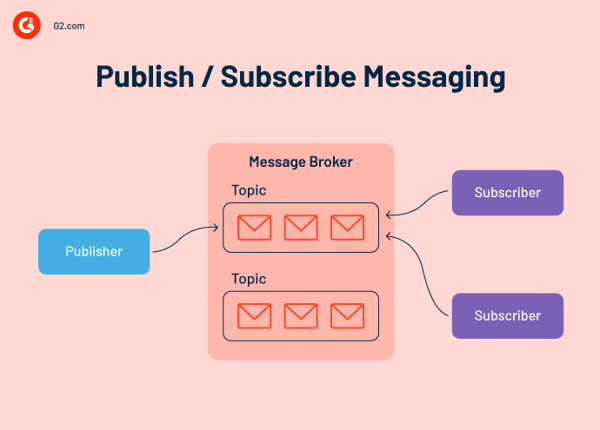These use cases show that message brokers aren’t just middleware; they’re foundational to building fast, flexible, and future-ready systems.
July 8, 2025
 by Keerthi Rangan / July 8, 2025
by Keerthi Rangan / July 8, 2025

Developers and architects spend their days juggling live deployments, debugging integrations, and keeping IT systems humming.
But in the midst of all this complexity, the invisible layer connecting it all, the message broker, often goes unnoticed. Ultimately, it leads to data silos, production fatigue, and fault isolation.
With a message broker, you can automate communication and message delivery between two or more systems to electronically exchange important deliverables. To ensure a seamless transfer of data, developers use message queue software, which acts as an intermediary between the sender system and the receiving system.
A message broker is software that routes messages between applications, services, or systems. It enables communication across different platforms or protocols by translating and relaying data. Message brokers decouple services, improve scalability, and ensure reliable message delivery in distributed architectures.
Message brokers are included in messaging middleware or message-oriented middleware (MOM) systems. This form of middleware gives developers a consistent approach to handling data flow among an application's components and focuses on its core functionality.
As systems scale and become more distributed, a message broker helps simplify communication, reduce dependencies, and improve service performance.
Here’s how a message broker helps:
With data exchange, message brokers allow for selective scheduling for primary tasks between software applications and allow dev teams to figure out glitches sooner.
Think of a message broker as a traffic controller for your data. Instead of services talking directly to one another and risking delays or downtime, it steps in to manage the flow, ensuring everything gets to the right place at the right time.
In a synchronous setup, one service sends a message to another and waits for a response before moving forward, a model that creates tight coupling and delays if the receiving service is slow or unavailable. This can be limiting in complex systems where services need to operate independently.
Message brokers solve this by enabling asynchronous communication. Instead of waiting for a response, the producer sends the message to the broker and moves on. The consumer processes it later when it becomes available. This allows for more efficient multitasking and reduces system downtime during service interruptions.
A producer generates a message and sends it to the message broker. The broker acts as an intermediary that receives, stores, and forwards the message to the appropriate consumer(s). Depending on how the broker is configured, this workflow supports both one-to-one (point-to-point) and one-to-many (publish/subscribe) patterns.
Once a message reaches the broker, it may be routed based on logic like topic filters, routing keys, or exchanges. If the consumer isn’t ready or available, the message can be stored temporarily in a message queue, ensuring it isn’t lost and is processed in the right order once the consumer is back online..
Message brokers handle several behind-the-scenes tasks that simplify service integration. These include:
Think of it like speaking different languages. Brokers act as interpreters, making sure services built in Python or Java or running in different clouds still understand one another.
This interaction model decouples services from each other; they no longer need to know when or how other services process messages.
This decoupling simplifies deployments, improves resilience, and allows teams to independently scale or maintain services without risking downstream failures. For organizations moving toward cloud-native, serverless, or microservices-based infrastructures, this kind of flexible communication model is foundational.
In practice, this architecture supports a wide range of use cases, from transactional workflows to event-driven pipelines, while ensuring that data is delivered reliably, only once, and in the right order.
By offloading the heavy lifting of message coordination, brokers enable scalable, fault-tolerant systems that can evolve independently and perform under pressure.
Message brokers support multiple messaging models that determine how messages are delivered and processed between producers and consumers. The choice of model impacts scalability, delivery guarantees, and how services interact.
Different workloads call for different messaging styles. Let’s break down the three models you’re most likely to encounter, and when to use each:
In the P2P model, a producer sends a message to a queue, and a single consumer retrieves it, ensuring the message is processed only once. This model is ideal for tasks that must not be repeated, like billing, payroll, or background jobs.
Tools like Amazon SQS, RabbitMQ, and Apache ActiveMQ support this model with features such as acknowledgments, retries, and dead-letter queues to ensure reliable, loss-free delivery.

The Pub/Sub model follows a one-to-many pattern: producers send messages to a topic, and all subscribed consumers receive them simultaneously. This model is perfect for real-time event distribution across services.
Use cases include notifying inventory, shipping, and analytics systems after an “order placed” event. Tools like Apache Kafka, Amazon SNS, and Google Cloud Pub/Sub are built to support this model at scale.

Hybrid brokers support both one-to-one (P2P) and one-to-many (Pub/Sub) patterns in a single system, offering flexible routing based on use case.
For instance, a logistics app might use P2P to dispatch a ride while using Pub/Sub to alert partners of traffic changes. Tools like RabbitMQ, Redis Streams, and Kafka enable hybrid delivery via routing rules, exchanges, or consumer groups.
These models form the backbone of modern messaging architecture, balancing precision, scale, and speed in distributed systems.
With so many message broker tools available, each optimized for different messaging patterns, throughput needs, and deployment models, it’s important to evaluate your system requirements before committing to one. The right choice depends not only on performance benchmarks but also on operational tradeoffs, team expertise, and architecture fit.
Here are the key factors to consider when choosing a message broker:
Choosing a broker is not just about raw performance. It is about finding the right tool for your messaging patterns, team workflow, and growth path.
Whether you are building for high-throughput analytics or tightly controlled transactional systems, aligning your choice with technical or business goals is key to long-term messaging success.
The message broker of 2025 is no longer just middleware; it’s a dynamic, context-aware communication layer woven into the infrastructure fabric. From serverless workloads to AI-driven routing, these trends point toward smarter, leaner, and more secure messaging solutions across cloud and edge.
There’s no one-size-fits-all message broker. Some excel in low-latency queues, others in event streaming or cloud-native scalability. Here's a snapshot of the most widely used tools in the message broker ecosystem:
Here are some of their main characteristics:
These tools are adept at handling complex messaging logic, storing technical documentation, and acting as an intermediary between the app and the developer.
From real-time event streaming to durable message queues, the right broker can make or break your system’s performance. G2 offers trusted reviews and side-by-side comparisons to help you choose the best fit for your messaging needs.
Compare top message queue and event streaming tools on G2 now.
While both message brokers and event streaming platforms handle inter-service communication, they serve distinct purposes and excel in different architectural scenarios.
.png?width=600&name=Message%20brokers%20vs.%20event%20streaming%20platforms%20(2).png)
Message brokers are designed to reliably route messages between producers and consumers, often using queue-based or pub/sub models. They’re ideal for transactional workflows, asynchronous task processing, and decoupling services in microservices or hybrid cloud environments. Brokers like RabbitMQ, Amazon SQS, and ActiveMQ focus on message durability, delivery guarantees, and support for multiple protocols, making them great for use cases where reliability and interoperability matter most.
Event streaming platforms, like Apache Kafka or Redpanda, focus on ingesting and processing high volumes of time-ordered event data in real time. Rather than discarding messages after delivery, they persist them for a configurable period, allowing for replay, audit, and batch processing. These platforms are built for data pipelines, real-time analytics, and stream processing, where scale, throughput, and long-term storage of event logs take priority over delivery guarantees.
In short: use message brokers when communication reliability is critical; choose event streaming when real-time data flow and processing are the priority.
Modern architectures often rely on various integration patterns to connect systems, services, and applications.
While message brokers, enterprise service buses (ESBs), and APIs all serve this purpose, they differ significantly in how they handle communication, scalability, and system decoupling.
| Feature | Message Broker | Enterprise Service Bus | API |
| Primary Purpose | Decouples services through async message routing | Centralized integration and orchestration of multiple services | Direct, synchronous communication between services |
| Communication Style | Asynchronous (queue or pub/sub based) | Synchronous and asynchronous | Typically synchronous (REST/HTTP), sometimes async (Webhooks, GraphQL Subscriptions) |
| Protocol support | AMQP, MQTT, STOMP, proprietary | XML, SOAP, HTTP, FTP, JMS, SMTP | HTTP/HTTPS, REST, gRPC, WebSocket |
| Routing Logic | Simple to complex routing via queues, topics, or exchanges | Advanced orchestration and mediation logic | No built-in routing, defined manually in client/server logic |
| Complexity | Lightweight and easy to set up | Complex, heavy, and harder to scale | Lightweight to moderate, depending on implementation |
| Scalability | High, suited for distributed and microservices architectures | Lower, harder to scale and debug | Depends on implementation, can scale via load balancers or API gateways |
| Resilience / Decoupling | High, decouples producers and consumers | A medium, centralized bus can become a bottleneck | Low — tight coupling between services unless decoupled via queues or events |
| Ideal Use Cases | Microservices, async workflows, background processing | Legacy systems, service orchestration, complex B2B integrations | Request-response services, third-party integration, frontend-backend calls |
| Examples | RabbitMQ, Kafka, Amazon SQS/SNS, ActiveMQ | MuleSoft, IBM Integration Bus, TIBCO ESB | REST APIs, GraphQL, OpenAPI, Postman-exposed endpoints |
Each approach has its place depending on your architecture. Choosing the right integration method comes down to your system’s complexity, performance needs, and how tightly or loosely you want your services coupled.
Message brokers play a central role in building scalable, resilient, and decoupled systems. Below are the core benefits they offer, not only from a technical standpoint, but also in terms of business impact and long-term architectural flexibility.
Whether you're scaling microservices or modernizing legacy workflows, message brokers provide the backbone for resilient, future-ready architectures.
One notable drawback of message brokers is the challenge of initiating and managing asynchronous operations that users might not have expertise in. Let's look at other drawbacks of implementing a message broker for data:
While message brokers help manage complex messaging logic, an incorrect deployment can cause unwarranted system crashes or expose your critical data.
Message brokers are essential for orchestrating reliable, asynchronous communication across distributed systems.
From fintech to cloud-native environments, they enable scalable, decoupled workflows that boost fault tolerance and real-time responsiveness.
These use cases show that message brokers aren’t just middleware; they’re foundational to building fast, flexible, and future-ready systems.
Use a message broker when your architecture requires asynchronous processing, offline tolerance, or event-based communication. Unlike REST APIs, brokers help decouple services and improve resilience, especially in microservices and hybrid cloud setups.
RabbitMQ is best for low-latency, transactional messaging between tightly scoped services. Kafka is better suited for large-scale, event-driven microservices that need persistent log storage and message replay capabilities.
Cloud-native brokers like Amazon SQS, SNS, and EventBridge integrate seamlessly with serverless platforms like AWS Lambda, enabling scalable, event-driven systems without manual queue management.
Pub/sub delivers messages to all subscribers in real time, making it ideal for broadcasting events. Queuing sends each message to a single consumer, which works well for task distribution and background job execution.
Managed brokers like Amazon MQ, Google Pub/Sub, and Azure Service Bus reduce infrastructure overhead and auto-scale with demand. Self-hosted options like Kafka or RabbitMQ offer deeper control but require more DevOps effort.
Look at throughput, latency, delivery guarantees, protocol support, and ecosystem compatibility. Use comparison platforms like G2 to filter tools that fit your architecture — whether it’s serverless, Kubernetes-native, or monolithic.
With a message broker, you can produce a solid and scalable producer-consumer architecture. It enables developers to automate the fulfillment lifecycle and exchange readable messages to ensure the overall smooth functioning of the infrastructure.
Message brokers are becoming increasingly important as businesses revamp their systems in anticipation of the cloud. Simply put, message brokers are essential for modern, technologically developing societies.
Track your ad-hoc software integrations with the best stream analytics software and monitor performance benchmarks and thresholds with ease.
This article was originally written in 2024. It has been updated with new information.
Keerthi Rangan is a Senior SEO Specialist with a sharp focus on the IT management software market. Formerly a Content Marketing Specialist at G2, Keerthi crafts content that not only simplifies complex IT concepts but also guides organizations toward transformative software solutions. With a background in Python development, she brings a unique blend of technical expertise and strategic insight to her work. Her interests span network automation, blockchain, infrastructure as code (IaC), SaaS, and beyond—always exploring how technology reshapes businesses and how people work. Keerthi’s approach is thoughtful and driven by a quiet curiosity, always seeking the deeper connections between technology, strategy, and growth.
RCS messaging is the long-awaited upgrade to the humble SMS.
.jpg) by Henry Cazalet
by Henry Cazalet
We all know that feeling: You hit the “send” button only to have that deep regret sink into...
 by Kristen McCabe
by Kristen McCabe
Consumer demand for personalized experiences is at an all-time high.
 by Keerthi Rangan
by Keerthi Rangan
RCS messaging is the long-awaited upgrade to the humble SMS.
.jpg) by Henry Cazalet
by Henry Cazalet
We all know that feeling: You hit the “send” button only to have that deep regret sink into...
 by Kristen McCabe
by Kristen McCabe


